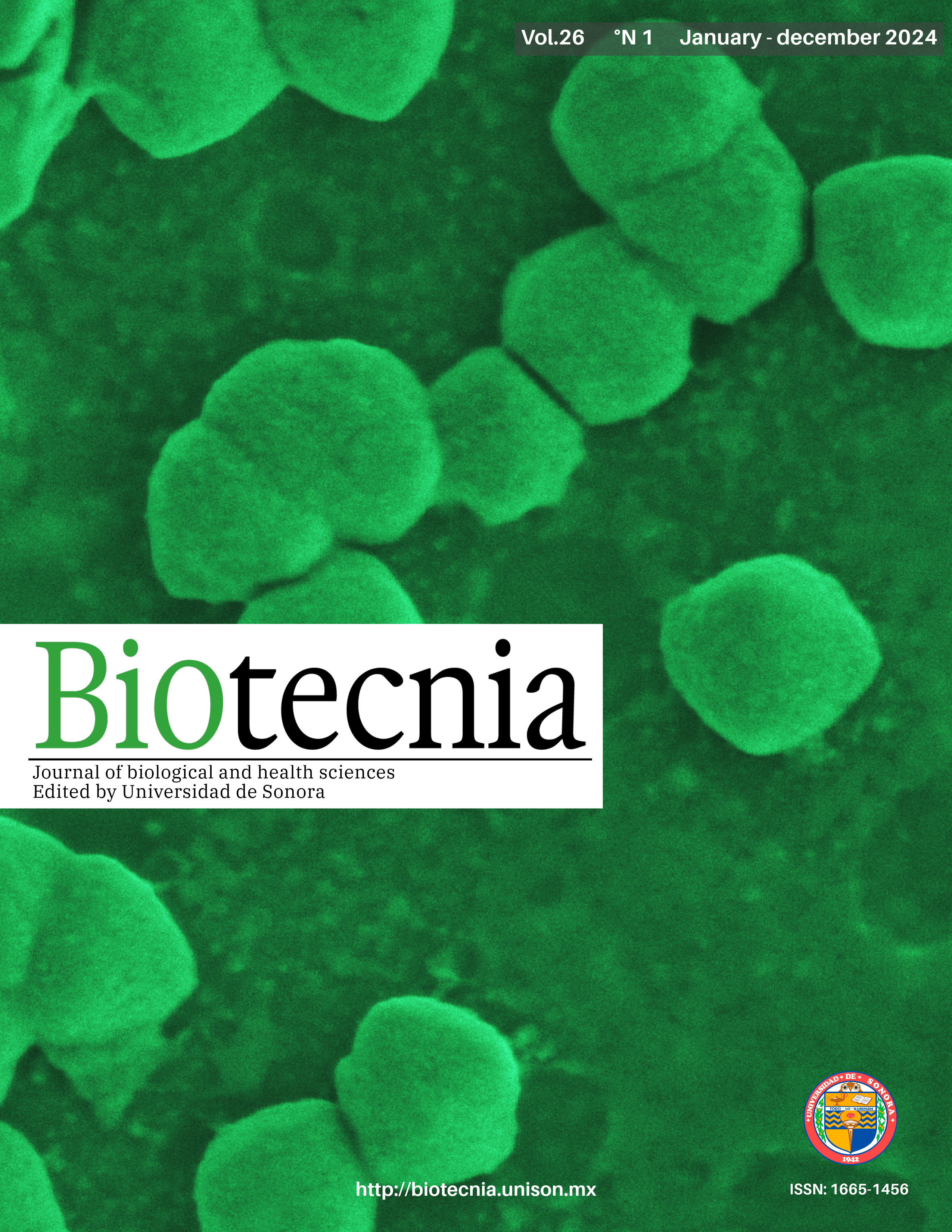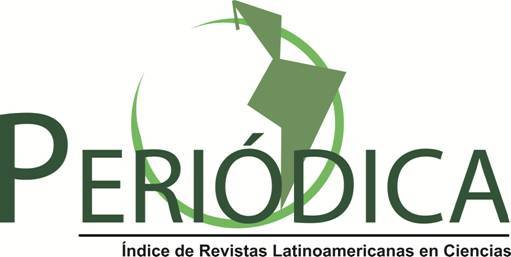Predominance of forest species and association of phytopathogenic fungi in trees of Mexico City
DOI:
https://doi.org/10.18633/biotecnia.v26.2156Keywords:
Cumulative population dynamics, phytosanitary status, cumulative incidenceAbstract
The objective was to determine the prevalence of forest species and identify phytopathogenic fungi in trees in CDMX. The trees were delimited in the Parque 18 de Marzo, based on the distribution of parks and gardens with native and introduced vegetation. From 2018 to 2020, diseased plant tissues were sampled and collected from tree species. The classification was through the manual of botanical species of the Valley of Mexico and the identification of fungi with taxonomic keys. We found 25 botanical families with significant differences (p≤ 0.05) in the diversity of native (39.51 %) and introduced (60.49 %) species. Leaves, shoots and branches presented leaf spots, chlorosis, cankers, death of vascular tissue, powdery mildew and rust. The degree of affectation with the highest impact on health and quality of the trees was Kirramyces epicoccoides, Aspergillus niger, Tubercularia sp. and Alternaria alternata (2.34, 2.58, 5.74 and 6.80 %, respectively). The cumulative incidence of cases registered in trees was 17.46 %. Ulmus parvifolia expressed greater epidemiological increase. A. alternata had a significant impact on population dynamics. The incidence of phytopathogenic fungi in tree species evidenced the general phytosanitary status that CDMX trees represent, which will allow establishing management measures for specific diseases.
Downloads
References
Agrios, G.N. 2005. Plant Patology. 5th Edition. Elsevier Academic Press, Amsterdam. 64-116 Pp. https://www.elsevier.com/books/plant-pathology/agrios/978-0-08-047378-9 http://biblioteca.utsem-morelos.edu.mx/files/asp/biologia/FITOPATOLOGIA%20-%20George%20N-Agrios.pdf (20 de enero de 2021).
Ainsworth, G.C. 2009. Introduction to the History of Micology. Cambridge University Press, London, England. 376p. https://books.google.com.mx/books?printsec=frontcover&vid=LCCN75021036&redir_esc=y#v=onepage&q&f=false
Alexopoulus, C.J. y Mims, C.W. 1985. Introducción a la Micología. Omega. Barcelona, España. 330p.
Aprea, A.M. y Murace, M.A. 2019. Problemáticas sanitarias del arbolado. Editorial de la Univer-sidad Nacional de La Plata (EDULP). Argentina. 156p. https://doi.org/10.35537/10915/82977
Balla, A., Silini, A., Cherif-Silini, H., Chenari Bouket, A., Moser, W.K., Nowakowska, J.A., Oszako, T., Benia, F. and Belbahri, L. 2021. The Threat of Pests and Pathogens and the Potential for Biological Control in Forest Ecosystems. Forests. 12: 1579. https://doi.org/10.3390/f12111579
Barnett, H.L. and Hunter, B.B. 1972. Illustrated Genera of Imperfect Fungi. 4a Edition, Burgess Publishing Co., Minneapolis, U.S.A. 234p. file:///C:/Users/mgrac/Downloads/Illustrated_genera_of_imperfect_fungi_fo.pdf
Carris, L.M., Little, C.R. and Stiles, C.M. 2012. Introduction to fungi. The Plant Health Instructor.
https://www.apsnet.org/edcenter/intropp/PathogenGroups/Pages/IntroFungi.aspx.
Cervantes B.M., Ortiz, R.B. y Reséndiz, M.J.F. 2019. Condición fitosanitaria del arbolado de la Tercera Sección del Bosque de Chapultepec. Revista Mexicana de Agroecosistemas. 6(1): 122-135. https://www.voaxaca.tecnm.mx/revista/docs/RMAE%20vol%206_1_2019/12%20RMAE_2019-10-Arbolado.pdf
Cibrián, T.D. Sánchez-Sámano, J. y Zamudio-Valencia, A. 2001. Diagnóstico fitosanitario del Olmo Chino (Ulmus parvifolia JACQ.) en la Delegación Iztacalco de la Ciudad de México. Revista Chapingo Serie Ciencias y del Ambiente. 7(2): 133-138. https://docplayer.es/29512700-Diagnostico-fitosanitario-del-olmo-chino-ulmus-parvifolia-jacq-en-la-delegacion-iztacalco-de-la-ciudad-de-mexico.html
Cibrián-Tovar, D., García, S.D. y Don Juan, B.M. 2008. Manual Identificación y Manejo de Plagas y Enfermedades en Viveros Forestales. CONAFOR. Ciudad de México, México. 12-122 Pp. http://www.conafor.gob.mx/biblioteca/MANUALES%20PROD%20PLANTA%20SANIDAD.pdf (08 de marzo 2021).
Cibrián, T. D. 2016. Manual para la Identificación y Manejo de Plagas en Plantaciones Forestales Comerciales. Comisión Nacional Forestal. SEMARNAT. Estado de México, México. 238 p. http://www.conafor.gob.mx/biblioteca/Manuales-Tecnicos/Manual_para_la_identificacion_y_manejo_de_plagas_en_plantaciones_forestales.pdf
Comisión Nacional Forestal (CONAFOR). 2007. Manual de Sanidad Forestal SEMARNAT. Zapopan, Jalisco, México. 76p. http://www.conafor.gob.mx:8080/documentos/docs/15/810Manual%20de%20sanidad%20forestal.pdf
Comisión Nacional Forestal (CONAFOR). 2023. Principales Indicadores Forestales. SEMARNAT, México. https://snmf.cnf.gob.mx/principaleindicadoresforestalesciclo-2015-2020/
Comisión Nacional para el Conocimiento y Uso de la Biodiversidad (CONABIO). 2016. La Biodiversidad en la Ciudad de México. CONABIO/SEDEMA. Ciudad de México, México. 350p. https://bioteca.biodiversidad.gob.mx/janium-bin/detalle.pl?Id=20210831105109
Díaz-Núñez, V., Sosa-Ramírez, J. y Macías-Medina, I.P. 2014. Diagnóstico Fitosanitario de la Vegetación en Ecosistemas Prioritarios de Aguascalientes, Comisión Nacional Forestal-Secretaria de Medio Ambiente del estado de Aguascalientes. Aguascalientes, México, México. 84 p. https://docplayer.es/24342604-Diagnostico-fitosanitario-de-la-vegetacion-enecosistemas-prioritarios-del-estado-de-aguascalientes.html
García, A. E. 2004. Modificaciones al Sistema Climático de Köppen: para adaptarlo a las condiciones de la República Mexicana. Instituto de Geografía, México: Universidad Nacional Autónoma de México. Ciudad de México, México. 97 p. http://www.publicaciones.igg.unam.mx/index.php/ig/catalog/view/83/82/251-1
Giraldo-Aristizábal, C.I., Mera-Velasco, Y.A., Rivas-Zúñiga, S.C., Muñoz-Lara, D.G., Acosta-Hílamo, L.M., Pérez-Muñoz, M., Villalba-Malaver, J.C. y Ordóñez-Hoyos, A.E. 2022. Evaluación fitosanitaria de Juglans neotropica y Quercus humboldtii en arbolado urbano de Popayán-Cauca, Colombia. Rev. Acad. Colomb. Cienc. Ex. Fis. Nat. 46(178): 169-181. https://doi.org/10.18257/raccefyn.1542
Hernández, G.L., Hernández, M.F.R. y Dago, D.Y. 2022. Organismos nocivos en el arbolado urbano en la ciudad de Pinar del Río, Cuba. Revista Cubana de Ciencias Forestales. 10(2): 230-243. http://cfores.upr.edu.cu/index.php/podium/article/view/753 http://scielo.sld.cu/pdf/cfp/v10n2/2310-3469-cfp-10-02-230.pdf
Instituto Nacional de Estadística y Geografía (INEGI). 2018. Anuario Estadístico y Geográfico de la Ciudad de México. INEGI. Ciudad de México, México. https://www.inegi.org.mx/app/areasgeograficas/?ag=09 (24 de abril de 2021).
Instituto Nacional de Estadística y Geografía (INEGI). 2021. Conjunto de datos vectoriales de uso del suelo y vegetación. Escala 1:250 000. Serie VII. Conjunto Nacional. Consultado [28 de abril de 2023]. https://www.inegi.org.mx/app/biblioteca/ficha.html?upc=889463842781
Kosman, E., Chen, X., Dreiseitl, A., McCallum, B., Lebeda, A., Ben-Yehuda, P., Gultyaeva, E. and Man-isterski, J. 2019. Functional Variation of Plant–Pathogen Interactions: New Concept and Methods for Vir-ulence Data Analyses. Phytopathology. 109: 1324-1330. https://doi.org/10.1094/PHYTO-02-19-0041-LE
Márquez, L.J. 2005. Técnicas de Colecta y Preservación de Insectos. Boletín Sociedad Entomológica Aragonesa. 37: 385-408. https://repository.uaeh.edu.mx/bitstream/handle/123456789/7510?show=full
Organización de las Naciones Unidas para la Agricultura y la Alimentación (FAO). 2018. El Estado de los Bosques del Mundo-Las vías forestales hacia el desarrollo sostenible. Roma, Italia. 153 p. http://www.fao.org/state-of-forests/2018/es/
Organización de las Naciones Unidas para la Agricultura y la Alimentación (FAOSTAT). 2021. Bosques. Tierras Forestales. Roma, Italia. http://www.fao.org/faostat/es/#data/GF
Procuraduría Ambiental y del Ordenamiento Territorial de la Ciudad de México (PAOT). 2018. Las Áreas Verdes de la Ciudad de México. Gobierno de la CDMX. México. 108p. http://centro.paot.org.mx/documentos/paot/libro/3PAOT_AreasVerdes_2018.pdf
Reséndiz, M.J.F., Guzmán, L.D., Muñoz, A.L.V., Nieto, C.P.P. y Olvera, L.P.C. 2015. Enfermedades foliares del arbolado en el Parque Cultural y Recreativo Tezozómoc, Azcapotzalco, D. F. Revista Mexicana de Ciencias Forestales. 6(30): 106-123. https://www.redalyc.org/pdf/634/63442410009.pdf
Reséndiz-Martínez, J. F., Guzmán, L.D., Muñoz, A.L.V., Olvera, L.P.C., Pacheco, H. Ma. and Arriola, V. J.P. 2019. Phytophagous mites and insects in the Recreational and Cultural Tezozomoc park trees, Azca-potzalco, Mexico City. Revista Mexicana de Ciencias Forestales. 10(56): 149-173. doi: https://doi.org/10.29298/rmcf.v10i56.454
Reséndiz, M.J.F., García, L.I.D., Ramón, M.M., Gutiérrez, R.M. y Ruiz, J.D. 2020. Salud forestal del arbolado de la segunda sección del bosque de Chapultepec de la Ciudad de México. Sociedades Rurales, Producción y Medio Ambiente, 19(36): 137-164. https://publicaciones.xoc.uam.mx/MuestraPDF.php
Riley, M.B., Williamson, M.R. and Maloy, O.C. 2002. Plant disease diagnosis. Spanish translation by José Carlos Ureta R., 2016. The Plant Health Instructor. 10.1094/PHI-I-2002-1021-01 https://www.apsnet.org/edcenter/disimpactmngmnt/casestudies/Pages/DiagnosticoEnfermedadesPlantas.aspx
Rodríguez, S.L. y Cohen, E.J.F. 2003. Guía de Árboles y Arbustos de la Zona Metropolitana de la Ciudad de México. Gobierno del Distrito Federal. Secretaría del Medio Ambiente. Ciudad de México. México. 210-383Pp. file:///C:/Users/Daniel/Downloads/GuaderbolesyarbustosdelazonametropolitanadelaCDMXL.RodrguezE.Cohen.pdf .
Rzedowski, G.C. de y Rzedowski, J.R. 2005. Flora fanerogámica del Valle de México. 2a. ed., 1a reimp., Instituto de Ecología, A.C. y Comisión Nacional para el Conocimiento y Uso de la Biodiversidad, Pátzcuaro (Michoacán), México. 44-1406Pp. https://www.academia.edu/41097296/Flora_fanerog%C3%A1mica_de_M%C3%A9xico
https://www.biodiversidad.gob.mx/publicaciones/librosDig/pdf/Flora_del_Valle_de_Mx1.pdf
Saavedra-Romero, L. de L., Alvarado-Rosales, D., Hernández-de la Rosa, P., Martínez Trinidad, T., Mora-Aguilera, G. y Villa-Castillo, J. 2016. Condición de copa, indicador de salud en árboles urbanos del Bosque San Juan de Aragón, Ciudad de México. Maderas y Bosques. 22(2): 15-27. https://www.redalyc.org/articulo.oa?id=61749306012
Secretaría del Medio Ambiente (SEDEMA). 2018. Inventario de Áreas Verdes. Gobierno de la Ciudad de México. México. [Consultado 20 diciembre 2023] https://www.sedema.cdmx.gob.mx/programas/programa/inventario-de-areas-verdes
Sosa, D.L., Méndez, J.G., García, M.A.A., Cambrón, C.S.S., Villarreal, J.Á.Q., Ruiz, C.G.G. and Montoya, J.C.J. 2018. Potential distribution of borers, defoliators, barking beetles and mistletoes in conif-erous forests of Mexico. Revista Mexicana de Ciencias Forestales. 9(47): 187-208. https://doi.org/10.29298/rmcf.v9i47.159
Shurtleff, M.C. and Averre, C.W. 1997. The plant disease clinic and field diagnosis of abiotic diseases. American Phytopathological Society, St. Paul, MN. https://my.apsnet.org/APSStore/Product-Detail.aspx?WebsiteKey=2661527A-8D44-496C-A730-8CFEB6239BE7&iProductCode=42171
Waller, J.M., Ritchie, B.J. and Holderness, M.D. 1998. Plant Clinic Handbook. CAB International, New York, NY, USA. 15-94Pp. https://sfu-primo.hosted.exlibrisgroup.com/primo-explore/fulldisplay/01SFUL_ALMA21162753280003611/SFUL
Downloads
Published
How to Cite
Issue
Section
License
Copyright (c) 2023

This work is licensed under a Creative Commons Attribution-NonCommercial-ShareAlike 4.0 International License.
The journal Biotecnia is licensed under the Attribution-NonCommercial-ShareAlike 4.0 International (CC BY-NC-SA 4.0) license.

















_(2).jpg)







